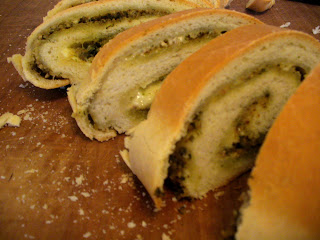Por mais que a gente ache bonito, é preciso podar com frequência o pé de manjericão, porque senão ele "spiga". Essa palavra, spigar, é outra daquelas que a gente jura que é português, mas não é. Significa estiolar, virar um monte de galhos com poucas folhas. Considerações linguísticas e jardinísticas à parte, volta e meia sou forçada a fazer pesto e, devo confessar, ando meio enjoada de massa al pesto. Então, há muito tempo eu tentei fazer um Strômboli, um pão recheado de pesto e mozzarella de búfala que vi no livro da Ursula Ferrigno. Não ficou bom. O pão ficou duro, pois o pesto e a água da mozzarella o umedeceram por dentro, alterando as sagradas proporções da panificação. Agora, diploma de chef na parede e tal, resolvi tentar de novo, dessa vez com massa de focaccia, que é um pão feito com muito azeite. A ideia era impermeabilizar. Funcionou. Claro que perdeu a crocância da focaccia, mas ficou um pão bem decente. Ao invés de mozzarella, que eu não tinha, usei nosso queijo colonial mesmo. Acho que o pessoal gostou, porque só sobrou a foto para contar a história.
Massa de focaccia eu sei de cor:
- 500g de farinha dura
- 250g de água
- 50g de azeite
- 5g de fermento seco ou 15g do fresco (nada de pó Royal, nem me falem nisso)
- 10g de sal
Se faz assim: misturar bem a farinha e o fermento seco. Diluir o sal na água. Incorporar aos poucos 90% da água, até formar o impasto. Acrescentar o azeite. Ver se precisa mesmo daqueles 10% de água que faltaram. Sovar, sovar, sovar até cansar e a bola de massa ficar lisinha. Deixar descansar coberta de azeite e filme plástico por uma hora. Abrir com o rolo, rechear com o queijo ralado e o pesto, enrolar tipo um rocambole, dobrar as pontas. Deixar crescer em forma untada por meia hora, assar em forno quente por mais meia hora. Não tem problema que o pão exploda e o recheio transborde. É essa a ideia, uma erupção. É por isso que a receita original se chama Strômboli, que é um vulcão. Capice?
Hello, non-Portuguese readers, here am I, your lazy translator! In this post, I talk about basil's regular need of pruning, otherwise it turns woody and with few leaves. This is why I make pesto now and then. If you are, like me, a little tired of pasta al pesto, try this bread filled with cheese and pesto. I was inspired by a recipe of Ursula Ferrigno, in her book Bringing Italy Home. She called her bread Stromboli, as the vulcan, because it is very probable that it bursts while baking, but that's the idea. I employ a foccacia recipe to do my bread. I think its high content of olive oil helps keeping the bread from getting hard because of the filling excessive moisture. So, I do it this way: 500g of all purpose wheat flour, 250g of water, 10g of salt, 15g of fresh active yeast and 50g of olive oil. Mix flour and salt, dilute yeast into water, pour 90% of it, creating an homogeneous dough. Pour the oil, knead and see if it really needs the last 10% of water. Knead, knead, knead until you get a soft and wrinkleless dough. Cover with oil and film, let rest for an hour. Open the dough, spread the filling - pesto and any grated mild cheese you love - roll it and fold the edges. Let rest, covered, for half an hour. Bake in pre-heated oven for half an hour. Let cool over a rack. Slice and let the eruption of flavour begin in your mouth. You will feel like a Pleasure Pompea!
Hello, non-Portuguese readers, here am I, your lazy translator! In this post, I talk about basil's regular need of pruning, otherwise it turns woody and with few leaves. This is why I make pesto now and then. If you are, like me, a little tired of pasta al pesto, try this bread filled with cheese and pesto. I was inspired by a recipe of Ursula Ferrigno, in her book Bringing Italy Home. She called her bread Stromboli, as the vulcan, because it is very probable that it bursts while baking, but that's the idea. I employ a foccacia recipe to do my bread. I think its high content of olive oil helps keeping the bread from getting hard because of the filling excessive moisture. So, I do it this way: 500g of all purpose wheat flour, 250g of water, 10g of salt, 15g of fresh active yeast and 50g of olive oil. Mix flour and salt, dilute yeast into water, pour 90% of it, creating an homogeneous dough. Pour the oil, knead and see if it really needs the last 10% of water. Knead, knead, knead until you get a soft and wrinkleless dough. Cover with oil and film, let rest for an hour. Open the dough, spread the filling - pesto and any grated mild cheese you love - roll it and fold the edges. Let rest, covered, for half an hour. Bake in pre-heated oven for half an hour. Let cool over a rack. Slice and let the eruption of flavour begin in your mouth. You will feel like a Pleasure Pompea!


Nenhum comentário:
Postar um comentário